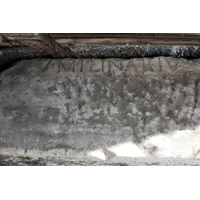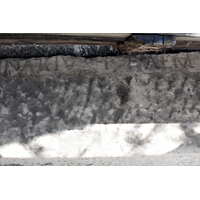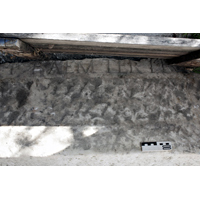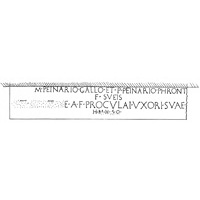 MAMA XI 162 (Kidyessos)
MAMA XI 162 (Kidyessos) 
Latin funerary inscription of Pinarii
- Type of monument:
- Latin funerary inscription.
- Location:
- Bal Mahmut (Kidyessos): built into a step in the vestibule of the mosque (1956); in use as a bench outside the mosque (2011).
- Description:
- White marble block, broken right, buried behind and above (1956).
- Dimensions:
- Ht. 0.31+; W. 1.72+; Th. 0.20+; letters 0.035-0.065.
- Record:
- Drawing; MB notebook copy; squeeze (1956/18); photographs (CVC, 2011).
- Publication:
- None.
- Date:
- Late first century BC or first century AD.
[- -]V · M(arcus) · Peinarius · Ṭ(iti) · f(ilius) · Aem(ilia) · Tertiu[s]
M(arco) · Peinario · Gallo · et · P(ublio) · Peinario · Phront[oni]
f(iliis) · sueis
〚[e]ṭ . . . . c. 6-8 . . . . 〛e · A(uli) · f(iliae) · Proculai · uxori · suae · [- -]
5H · M · H · S · O ·
... M(arcus) Peinarius Tertius, son of T(itus), of the tribe Aemilia, for M(arcus) Peinarius Gallus and P(ublius) Peinarius Fronto his sons and for 〚- - - - -〛 Procula, daughter of A(ulus), his wife. This tomb follows... (?)









Lines 2-5 of the inscription were recorded by Ballance in 1956, at which point line 1 (not seen by Ballance) was presumably concealed in the mosque steps. By 2011, the stone had been removed from the steps of the mosque, and was in use as a bench in the mosque garden; lines 2-5 had been worn to illegibility, but line 1 was now fully visible.
The family’s gentilician (Lat. Pinarius) is not an especially common one; the patrician family of the Pinarii was one of the oldest at Rome. The Kidyessian Pinarii were presumably Italian immigrants rather than Phrygians who had been granted the citizenship, although I am unable to find any plausible connection with any other holders of the nomen. Most likely we are dealing with a Italian negotiator who settled permanently with his family at Kidyessos in the Late Republican period: for this phenomenon, see Thonemann 2010: 169-74; for other Latin funerary inscriptions of the Late Republican and early Imperial period from central Phrygia, see e.g. MAMA VI 202 (Apameia: bilingual); MAMA XI 115 (1956/61: Akmoneia: L. Aelius Venustus). A legionary tribune by the name of Q. Pinarius L.f., also of the tribe Aemilia, is attested at Ephesos in the triumviral period: I.Ephesos 705A; AE 1992, 1581; Schäfer 2000: 131-2.
It is difficult to be certain of the date of the monument. The earliest coinage of Kidyessos, minted under Domitian, was struck in the name of a high-priest Flavius Peinarius (ἐπὶ Φλαουίου Πειναρίου ἀρχιερέως: Aulock 1980: 70-2, 127-8; RPC II 1390-2), clearly a member of this same family. In line 3, Procula’s gentilician has been deliberately erased, for unknown reasons. In line 4, I can offer no convincing resolution of the abbreviation HMHSO. A tiny handful of examples are known where the common formula h(oc) m(onumentum) h(eredem) n(on) s(equetur) is inverted (e.g. CIL VI 11451; 27839; 38697, hoc monumentum heredem sequitur), but I can find no parallel for the addition of an O: conceivably hoc monumentum heredes sequitur omnes?